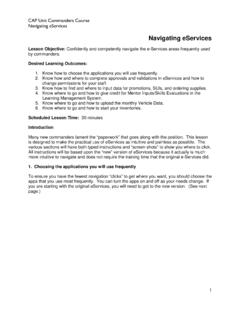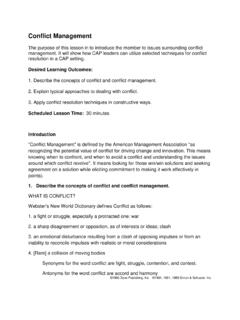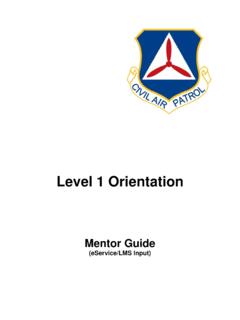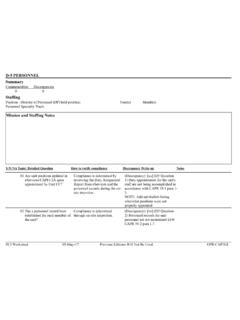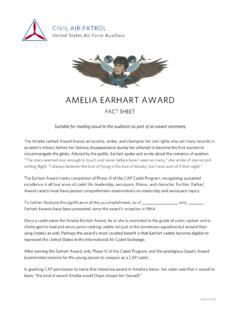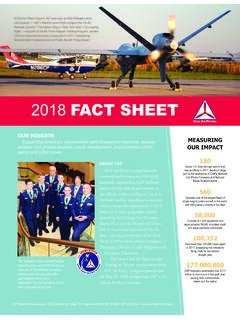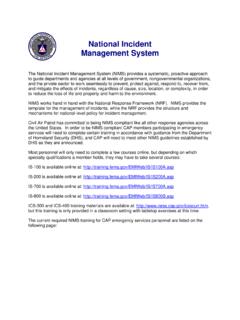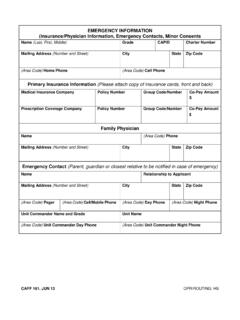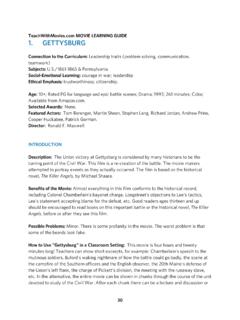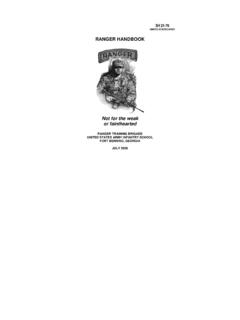Transcription of CADET STAFF HANDBOOK - Civil Air Patrol
1 CADET STAFF HANDBOOK CAPP 60-31 April 2022 GOAL SETTING & PLANNING LEADERSHIP & MENTORING AIR FORCE TRADITIONS POSITION DESCRIPTIONS ORGANIZATIONAL CHARTSC adet STAFF HANDBOOK - Apr 4/12/22 3:19 PM Page 1 CAPP 60-31 April 2022 CADET STAFF HANDBOOK PREFACE This HANDBOOK is a resource for cadets and the senior members who supervise and guide them. What is the role of the CADET STAFF ? How do senior members manage the STAFF program? This HANDBOOK answers those questions and more. It discusses how to design a CADET STAFF , select cadets for STAFF service, and make STAFF service a learning experience. It also includes practical tools for cadets. There are detailed descrip-tions for the major CADET STAFF positions, resources for conducting uni-form inspections, tips for planning squadron meetings, and more.
2 Summary of Changes This edition includes only one substantive change, the addition of a CADET Driver s Aide as a temporary position (p. 53). A handful of minor, non-substantive changes have been made, updating web addresses, and form numbers. The previous edition, November 2016, may still be Part 1 Introduction for Commanders1 Part 2 Tools for CADET STAFF Introduction8 Goal Setting & Planning10 Leadership & Mentoring18 Air Force Traditions31 Appendix 1 CADET Position Descriptions38 Appendix 2 Organizational Charts54 CADET STAFF HANDBOOK - Apr 4/12/22 3:19 PM Page 2 Part 1 INTRODUCTION FOR COMMANDERS INTRODUCTION Cadets learn by leading. Service on a CADET STAFF gives cadets an opportunity to apply their leadership skills and develop their potential. Their learning is especially effective because the cadets are actively engaged in their development as leaders.
3 Cadets learn to lead by actu-ally leading, instead of passively receiving knowledge from a lecturer. Cadets will have a higher motivation to learn and develop their poten-tial if they see that as CADET STAFF they have a degree of autonomy that gives them a real stake in the success of the squadron. Therefore, instead of senior members assuming the role of a classroom teacher and being the sole, infallible source of information, the senior leadership should share control of the squadron and allow cadets to explore the art of leadership by leading junior cadets. In the CADET Program, senior members coach and mentor the CADET STAFF . DESIGNING YOUR CADET STAFF When selecting cadets to serve on the CADET STAFF , senior members should try to tie-together three things: the CADET s leadership skill, their rank, and their job.
4 For example, new cadets are learning how to follow and contribute to the team. They wear an airman s insignia, and therefore should be assigned a position appropriate for a novice, low-ranking leader, such as element leader. CADET master sergeants, on the other hand, know how to follow and have moved on to learn how to take charge of small groups and execute plans their superiors have developed. Therefore, these CADET NCOs should be assigned positions that match their rank and skill, such as flight sergeant or first sergeant. The Leadership Expectations chart on pages 20-21 illustrates these STAFF HANDBOOK - Apr 4/12/22 3:19 PM Page 3 Tailoring the Challenge This principle of tying leadership skill, rank, and position together is all about providing a tailor-made leadership challenge for each CADET .
5 However, this may result in the squadron needing to keep some STAFF positions vacant. For example, if the ranking CADET is an airman, their position still should be limited to element leader because we want to match them with a job that is appropriate for their leadership skill and rank it would be premature to appoint that CADET as CADET command-er. If the ranking CADET is a master sergeant, that CADET could serve as flight sergeant or first sergeant, but higher positions like flight com-mander and CADET commander should remain vacant. By assigning cadets to positions that match their rank and skill, we ensure each CADET has a leadership challenge that is appropriate. Further, by keeping high positions vacant until cadets achieve rank commensurate with the positions, we give the ranking CADET (s) addi-tional challenges to strive towards and a reason to pursue promotions.
6 As the cadets advance in CAP and mature as leaders, they can gradu-ally be promoted into higher positions on the CADET STAFF . ORGANIZATIONAL CHARTS If units provide tailor made challenges for ranking cadets, each unit is apt to have a unique organizational structure. There is no one size fits all solution or standard organizational chart for a CADET unit. Each squadron should choose an organizational structure that is appropriate for its mix of cadets, be the squadron big or small, top-heavy or bottom-heavy. This HANDBOOK includes organizational charts designed for a variety of circumstances. Unit commanders should select the organizational structure best suited for their unit, or even customize one of the orga-nizational charts suggested in this HANDBOOK . 2 CADET STAFF HANDBOOK - Apr 4/12/22 3:19 PM Page THE CHANGING ROLE OF SENIOR MEMBERS A squadron s CADET STAFF is a dynamic system as junior cadets advance and experienced cadets outgrow the CADET Program, the STAFF structure will need to change.
7 What does this mean for the cadets mentors, the senior member STAFF ? The level of adult involvement the degree to which the senior STAFF takes a hands-on or hands-off approach should depend on the matu-rity of the CADET STAFF . Well-Established Units For example, in well-established units that have a number of mature CADET officers, the CADET STAFF should be afforded considerable autono-my. It is the CADET officers who should be setting goals, planning activi-ties, and making decisions for the unit, under senior supervision. In sit-uations like this, senior leaders can delegate many leadership functions to the CADET STAFF , while still supervising and mentoring the cadets. New or Rebuilding Units In contrast, if the unit is bottom-heavy perhaps it is brand new or rebuilding the senior STAFF will need to take a more hands-on approach.
8 In the absence of mature CADET officers, the senior STAFF must fulfill the goal-setting, planning, and decision-making functions until junior cadets acquire some rank, maturity, and leadership skills. The senior STAFF may even need to instruct cadets in fundamental sub-jects like drill and the wear of the uniform, performing duties normally assigned to CADET NCOs. Hopefully, cadets will progress quickly and earn entry-level leadership positions. When that happens, the senior STAFF should gradually delegate more authority to the cadets and enlarge the CADET STAFF s sense of autonomy. In other words, every time the CADET STAFF takes one step forward in the CADET Program, the senior STAFF should take one step back. The Importance of CADET Position Descriptions How much authority should be granted to cadets?
9 What is the ideal scope of their responsibilities? The answers to these questions are found in the CADET STAFF position descriptions. After finding an appropriate 3 CADET STAFF HANDBOOK - Apr 4/12/22 3:19 PM Page 5staff assignment for a CADET , the senior leadership should grant the CADET enough space or autonomy to perform that job, as it is laid out in the position description. Likewise, the scope of the CADET s responsibili-ties should be limited by their position description. In other words, flight sergeants should have freedom to perform flight sergeant duties, but only flight sergeant duties. TERM LIMITS Commanders have flexibility in determining how long cadets serve in their STAFF positions. There is no standard term of office. However, unit commanders are encouraged to set term limits for three reasons: (1) Term limits make it clear cadets must work hard if they are to continue enjoying the opportunity of serving on the CADET STAFF .
10 STAFF service is a privilege, not a right. (2) Term limits allow other qualified cadets opportunities to lead. CAP wants to develop the leadership potential of all cadets by assigning them jobs befitting their rank and skill. Term limits can help ensure every deserving CADET has a chance to lead. (3) Term limits create a face-saving measure if cadets are unable to perform their duties, for whatever reason. It is better for a CADET to be assigned to a different position at the end of the term, rather than be fired because of poor performance. STAFF service is supposed to be a positive learning experience. The duration of the term should depend on the situation. If the unit is new, with no cadets holding significant rank, cadets could be rotated through element leader positions on a monthly basis. If the squadron has a well-defined corps of CADET officers and NCOs, terms could be 6 to 12 months long.
